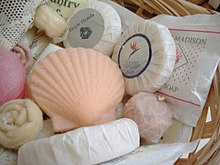Caustic soda
| General | |||||||
|---|---|---|---|---|---|---|---|
| Surname | Caustic soda | ||||||
| Molecular formula | NaOH | ||||||
| Brief description |
colorless solution |
||||||
| External identifiers / databases | |||||||
|
|||||||
| properties | |||||||
| Molar mass | 39.997 g · mol -1 | ||||||
| Physical state |
liquid |
||||||
| safety instructions | |||||||
|
|||||||
| As far as possible and customary, SI units are used. Unless otherwise noted, the data given apply to standard conditions . | |||||||
Sodium hydroxide is the name given to alkaline solutions of sodium hydroxide (NaOH) in water.
properties
Sodium hydroxide dissolves very well in water with strong heat generation. An aqueous solution saturated at room temperature contains 1260 g sodium hydroxide per liter of water. Caustic soda is one of the most widely used laboratory and industrial chemicals . Concentrated caustic soda has a very corrosive effect on the skin and even very dilute caustic soda can damage the cornea of the eyes to such an extent that it leads to blindness.
One molar sodium hydroxide solution (a solution that contains one mole of NaOH (40 g) in one liter; corresponds to about 3.9% by weight) has a pH value of 14.
| Mass fraction of NaOH in% by weight | 4.0 | 10.0 | 20.0 | 30.0 | 40.0 | 50.0 |
|---|---|---|---|---|---|---|
| Molecular concentration of NaOH in mol / l | 1.04 | 2.77 | 6.09 | 9.95 | 14.30 | 19.05 |
| Mass concentration of NaOH in g / l | 41.7 | 110.9 | 243.8 | 398.3 | 572.0 | 762.2 |
| Density of the solution in g / cm 3 | 1.043 | 1.109 | 1.219 | 1.328 | 1.430 | 1.524 |
Extraction
Sodium hydroxide solution is usually by electrolysis of an aqueous sodium chloride - solution won. This method is called chlor-alkali electrolysis . Various technical processes can be used for this. The reaction equation for the overall reaction is:
This also produces chlorine . The chemical industry's great need for caustic soda has made a significant contribution to the development of chlorine chemistry .
Other metal salts can also be converted into their hydroxides by means of electrolysis . For example, if you use potassium chloride instead of sodium chloride, you get potassium hydroxide . Chloralkali electrolysis is an endothermic reaction . The energy required is supplied in the form of electricity.
Caustic soda can also be washed from red mud .
use
- Synthesis of various chemicals, for example formic acid , sodium hypochlorite , sodium phosphate , sodium sulfide .
- Production of various soda soaps .
- In the chemical industry for the neutralization of acids in a large number of chemical processes.
- Digestion of bauxite and other ores ( Bayer process for the production of aluminum )
- Processing: Removal of old paint ( paint stripper ), regeneration of rubber and ion exchangers , refinement of cotton ( mercerization ), cellulose production ( cellulose ).
- In the food industry: rinsing bottles in beverage filling systems, removing greasy and oily contaminants, cleaning stainless steel tanks , removing the peel from fruit and vegetables, in the production of pretzels as a food additive E 524 for the brown color and the "soapy" taste, for pickling olives.
- In agriculture and dairies for cleaning of milking machines , hoses, pipes and milk cooling tanks .
- In beekeeping: for cleaning beehives and frames.
- In the pharmaceutical industry, acidic, poorly soluble drugs , for example hexobarbital , isotretinoin , ketorolac , are often converted into sodium salts with sodium hydroxide solution , which are then more water-soluble or have other galenic advantages.
- In the household as a drain cleaner .
- In printed circuit board manufacture, for developing the layout previously transferred to the photo-coated circuit board with ultraviolet radiation .
storage
Sodium hydroxide solution should never be stored in vessels with ground glass stoppers. With the carbon dioxide from the air, sodium hydrogen carbonate is formed on the joint :
This salt crust sticks the joint to the sleeve. In addition, sodium hydroxide attacks the most glasses, and therefore it above a concentration of 0.1 to n generally recommends an alkali- inert containers such. B. made of polyethylene , with screw cap or short-term rubber stopper if necessary. Glass vessels are completely out of the question for volumetric NaOH solutions.
disposal
Like all alkalis, caustic soda must be neutralized with suitable acids before being discharged into the sewer system . If necessary, the concentration of the resulting salts must then be reduced by dilution. Small amounts, such as those that arise when using certain cleaning agents, only need to be diluted sufficiently.
Individual evidence
- ^ A b c d Hermann Hager: Hager's handbook of pharmaceutical practice for pharmacists, drug manufacturers, chemists, doctors and medical officials, second volume . Springer-Verlag, 2013, ISBN 978-3-642-49767-4 , p. 222 ( limited preview in Google Book search).
- ↑ a b Entry on sodium hydroxide in the GESTIS substance database of the IFA , accessed on June 18, 2015(JavaScript required) .
- ↑ Entry on sodium hydroxide in the Classification and Labeling Inventory of the European Chemicals Agency (ECHA), accessed on August 1, 2016. Manufacturers or distributors can expand the harmonized classification and labeling .
- ↑ a b Entry on caustic soda. In: Römpp Online . Georg Thieme Verlag, accessed on August 1, 2015.
- ^ Brockhaus ABC Chemie , VEB FA Brockhaus Verlag Leipzig 1965, p. 928.
- ^ Axel Kleemann , Jürgen Engel, Bernd Kutscher and Dietmar Reichert: Pharmaceutical Substances , 4th edition (2000), 2 volumes published by Thieme-Verlag Stuttgart, ISBN 978-1-58890-031-9 ; online since 2003 with biannual additions and updates.




